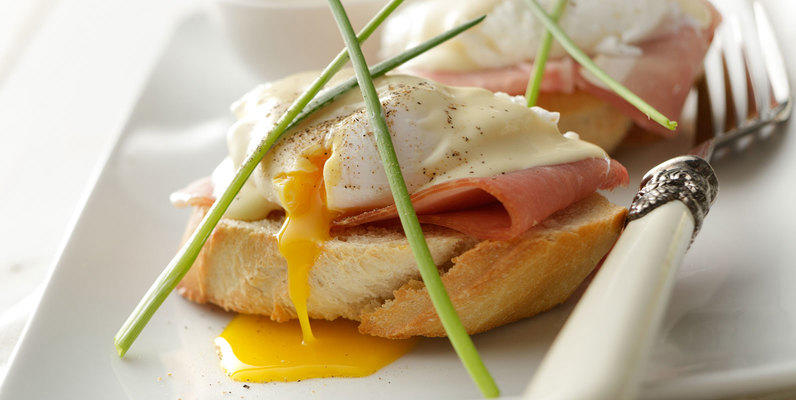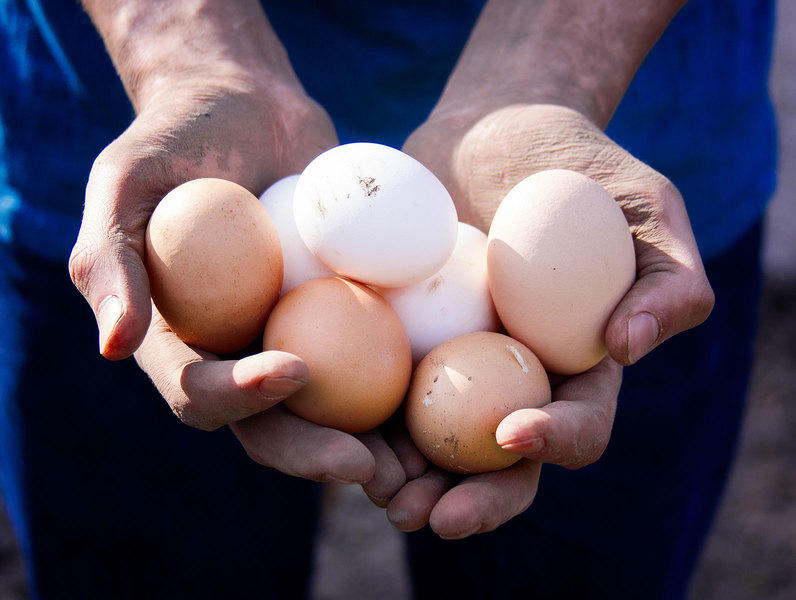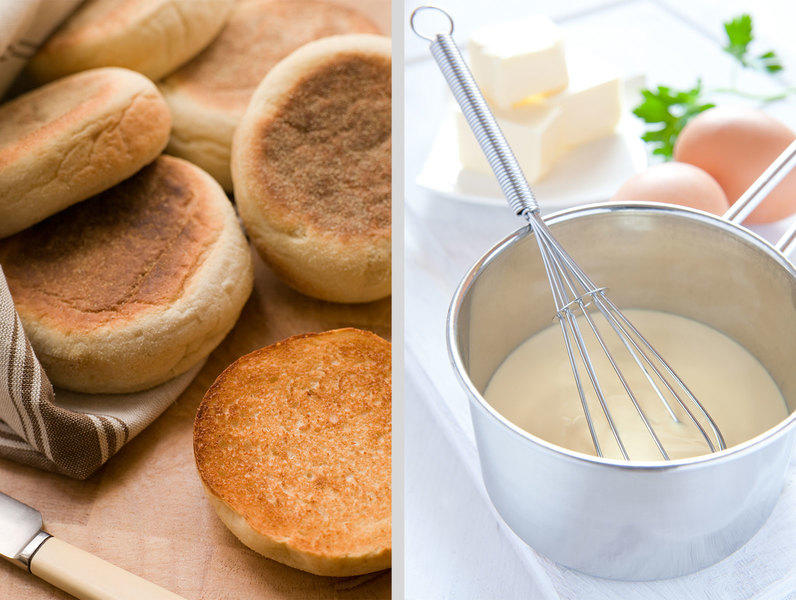01/26/2017
Inside the EDG Kitchen
The job of the research team at EDG is to dig deep and just when you think you’ve arrived… dig deeper. It’s no wonder that our group will uncover great stories of intrigue while researching even the simplest subject. Last month our team began examining classic brunch options. No menu option discussed sparked controversy quite like eggs benedict.
The story of eggs benedict is a mystery wrapped in an enigma. The main characters were a pope, wealthy socialite, a very hung over New Yorker or an impossible amalgamation of all three (you read that right and yes, we know it sounds like a terrible set-up for a joke).
Some give credit for the dish to Pope Benedict XIII, who ruled the Vatican from 1724 to 1730. He was not a healthy man and lived on a strict diet of poached eggs and toast. Since the diet was rather bland, the eggs were dressed in a lemon-based sauce, at his request. The addition of ham, the substitution of an English muffin and a sliced truffle garnish were later embellishments.
One account involved the claims of Delmonico's that two of the restaurant’s regular diners in the 1860s, Mr. and Mrs. LeGrand Benedict, are reported to have requested the elements of eggs Benedict one morning, after which it became popular off-menu. Delmonico chef, Charles Ranhofer, published the recipe for Eggs à la Benedick in 1894 making it a front running theory.
However, of all of the great stories we heard, the idea that the ultimate brunch dish was invented by a hard-partying rogue won us over. Lemuel Benedict, a retired stock broker claimed he had wandered into the Waldorf Hotel in 1894 hoping to find a cure for his morning hangover. He ordered "buttered toast, poached eggs, crisp bacon, and a "hooker of hollandaise". Oscar Tschirky the famed maitre d'hotel, was so impressed with the dish that he put it on the breakfast menu but substituted ham for the bacon and a toasted English Muffin for the toast.
We aren’t quite sure which version is true but can agree that it is our favorite go to brunch. In honor of our amazing research team EDG chefs crafted a traditional Benedict in our test kitchen using local, farm to table ingredients. We offer a resource guide to creating our version of the perfect benedict.
Resource Guide
Model Bakery - St. Helena, CA: For 90 years, The Model Bakery has been a part of the Napa Valley Culinary scene, providing discerning residents and visitors some of the best breads and pastries in Northern California. The Model Bakery English Muffins are everyone’s favorite (including Oprah, featured on Oprah’s Favorite Things 2016). They lovingly hand make each and every muffin, ensuring buttery flavor, fluffy texture and crisp crust.
Wise Acre Farm – Windsor, CA : Wise Acre eggs are grown locally in Sonoma County, humanely on a farm priding itself on its sustainable practices. The hens are fed organic grains containing no GMO’s or antibiotics, chickens are allowed to roam open pastures, and are hand raised. The result is yolks that stand up taller, are much richer, darker in color, and whites that don’t run.
Black Pig Meat Company – Sebastopol, CA: Black pig meat co. is the brainchild of chefs Duskie Estes from Zazu kitchen + farm. The pigs are sustainably raised on family farms that respect the land and the animals in their care. The pigs are heritage breed, raised without antibiotics and hormones, and are allowed to roam free.
Strauss Family Creamery – Marshall, CA: Since 1994 this family-owned and operated business, has been dedicated to making the highest quality and minimally processed dairy products. The dairy and creamery are located in the small town of Marshall on the Northern California Coast, they were the first certified organic dairy west of the Mississippi River and the first 100% certified organic creamery in the US.
Classic Hollandaise Recipe (Yields two cups)
Ingredients
1 lb of butter, clarified
1/8 teaspoon Salt, (kosher preferred)
1.5 oz White Wine Vinegar
1 oz cold water
6 Egg Yolks
2 tablespoons of lemon juice
Salt and Cayenne Pepper to taste
Procedure
- Place salt and vinegar into a sauce pan and reduce by 2/3. Remove from heat and add water.
- Transfer reduction to a stainless-steel mixing bowl.
- Add egg yolks and beat over a simmering pot of water until the egg yolks become thick and creamy. (make sure the eggs do not exceed 150°F).
- Once the egg yolks have reached the desired thickness, remove from heat. Using a ladle, slowly drizzle in the warm clarified butter until it is completely incorporated.
- Finish by seasoning your hollandaise with salt, lemon juice and cayenne pepper to taste.
- Adjust final consistency with a little bit of warm water to both lighten the sauce and give it better flow. If the hollandaise becomes too thick, thin the sauce with a couple drops of warm water.
- Keep warm in a double boiler until ready to serve. The best holding temperature is about 145°F. This temperature discourages the growth of bacteria and is hot enough to keep your hollandaise from solidifying.





